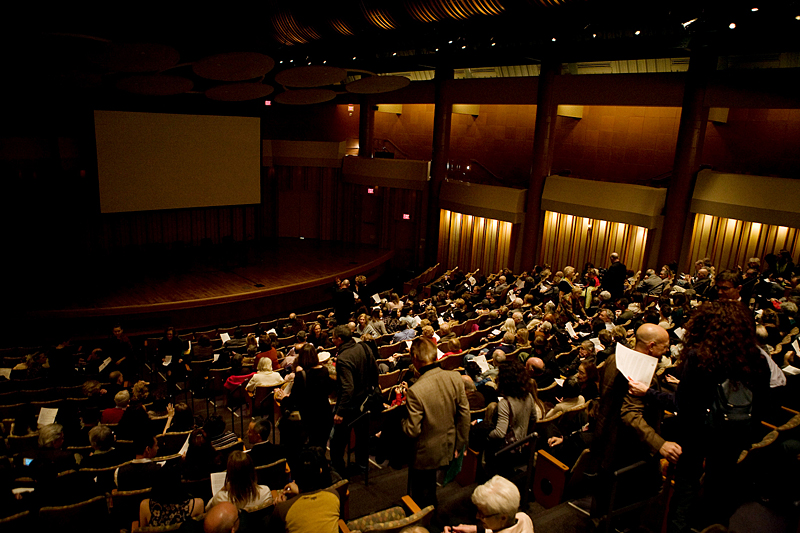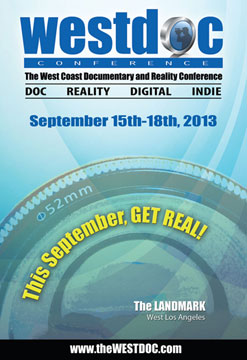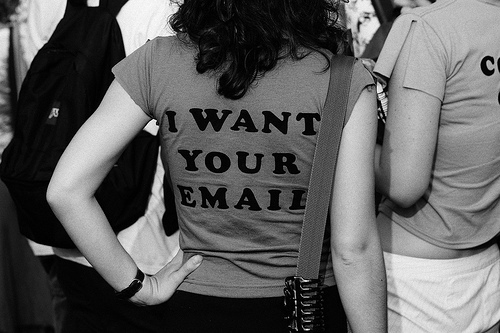
International broadcast sales for documentary and WESTDOC Conference
A interview with the West Coast Documentary and Reality Conference (WESTDOC) Co Founder Richard Propper. Mr. Propper is also CEO and Director, International Licensing and Acquisitions at Solid Entertainment, a sales agency specializing in documentary films.
TFC: How long have you been doing international sales and with which entities and films?
RP: “I have been licensing non-fiction programming for 19 years. It wasn’t something I fell into, I had a great desire to combine the entertainment industry and international business – and I’m a current affairs and history junkie. Having completed film school and working for a small studio for years in post production, I saw a vast number of filmmakers with great documentary films, but no knowledge of what to do next. I wanted to be the first call for filmmakers when they thought about international sales.”
“Solid Entertainment has been successfully licensing programs worldwide for almost two decades via such broadcasters as: Animal Planet, ARTE, BBC , BBC2, BBC Horizon, BSkyB, Channel 4, Canal+, The Discovery Channels (worldwide), France 2/3, France 5, HBO, History Channel, M6, NBC, NHK, NOS-EO, National Geographic Channels(worldwide), Odyssee, ORF, Orbit, Planete, Premiere, Showtime, STAR Entertainment Channel, SPIEGEL TV, STERN-TV, SBS6, SF-DRS, TaurusFilm, The Travel Channel, TSR, TV Ontario, RAI, RTI, RTP, REAL-TV, VTM, ZDF.”
“At Solid Entertainment, our deal terms are pretty standard. A flat rate of 30%. No deduction for expenses. 3 year exclusive term of representation.”
TFC: What trends do you see on sales side for documentaries? Please be specific in terms of territories, rights, prices, types of films that perform v not etc.
RP: “They love (insert doc subject here) in Japan!” – Every new filmmaker I’ve ever met. – Richard Propper
“I’m going to throw a bucket of cold water on many peoples perceptions of the international broadcast marketplace. In many ways, its tougher now than ever before. There’s a huge oversupply of programs. Technology has worked wonders for the creation of content, leading to more of it. The non-fiction broadcast marketplace has been impacted by Reality TV. Channels need ratings and they have only so many hours they can license and co-produce. The line has blurred between documentaries and reality, so channels gradually began to license more and more Reality. Most territories in Europe still license good documentaries, but license fees have been declining for a few years. Asia and Latin America continue to pay modestly. Larger US broadcasters now want all rights deals. It didn’t use to be that way, a producer could count on the international rights as his/her “back end monies.” Not anymore.”
“Today, we see around $8,000 for an hour in Germany. We used to see $20,000. France, about $7,500 and it used to be $15,000. The UK – as high as $80,000, now $25,000. Generally, all the digital, free follow along rights go with the license fee. Pay VOD is still retained by the producer. We’ve had to sell more content overall and look harder for the opportunities.”
“Uniquely, American programs don’t do very well in the international marketplace. World history, nature and wildlife, buried treasure stories, science and technology stories all do well. American social issues or narrow political issues are a much harder sale. When was the last time you saw a great Italian documentary? You haven’t. Americans think our programs should sell everywhere, but we don’t reciprocate by programming other countries films on our networks. The international marketplace looks for programs that are somehow universal. It’s an art, not a science in producing programs that are attractive to the worldwide audience. I will say that some buyers recognize a well told story, others don’t. If it’s all talking heads or about some strange subculture – it won’t sell. We look at everything that comes into our office for representation – there are always surprises. If you haven’t captured the audience within the first 10 minutes, its likely the buyers aren’t going to stick around either.”
“Running times are important. If your dream is to make a feature doc, then try to come in at 75 – 100 minutes. Have a 50 minute cut-down planned for the broadcast one-hour slots. 90% of the world broadcast slots are one-hour. If there’s only a feature version, it has to compete with every Academy nominated doc or Morgan Spurlock’s or Michael Moore’s latest feature. It a very hard road if you’re not prepared. But it’s not all bad news.”
“The digital marketplace is starting to come into its own. While broadcast is challenging, there is a long tail strategy with digital – it just needs a little more time to stand on its own two legs. It takes strategy to get a good film released onto multi-platforms and various times. These strategies are being pioneered now. That is exciting. A larger audience for many films is out there, and technically there’s a way to deliver it. You just have to find and engage that audience.”
TFC: Explain the DVD landscape.
RP: “While the general focus, and rightly so, has been on VOD and a la carte program sales, I’ve found in the last year some DVD distributors who are looking for content. Keep in mind that there’s still a huge population of people who have this machine connected to their TV that provides supplemental content. We’ve had good luck getting a 4 part limited series and larger multi-episode series into Costco and Target. It’s short term sales, but its also unexpected revenue stream. VOD and a la carte programming is great, but it requires working with the right groups to get your content out there. While filmmakers are waiting for the magic formula to distribute digitally, DVD still has a place. It’s going away, but not as quickly as you might think.”
TFC: What is WESTDOC and why should filmmakers attend?
RP: “Over nearly 2 decades of traveling to television markets and film festivals, I realized that LA needed a substantial documentary conference of its own. One that wasn’t sponsor driven, nor a fortune to attend. Chuck Braverman is a friend and producer, who for years would run into me at various conferences and ask me why there wasn’t a decent conference in LA (I was President of IDA at the time) and proposed that we start one. I begged off for a time and then thought – why not? WESTDOC was born.”
“While there are some terrific conferences in other cities, LA really has this fractured creative community. Most filmmakers belong to several organizations. But where are the conferences that bring in the decision makers? Here is a true story. I was at a conference in Cannes (MIP or MIPCOM) having a meeting with someone who worked 25 minutes away from my office. I had traveled 9,000 miles to meet her. How ridiculous. With WESTDOC we’re getting these decision makers out of their offices and into an event to connect with the LA creative community.”
“When Chuck and I first sat down, we selected the best pieces from IDFA, HOT DOCS, MIP, NATPE, and all the rest. When we were done with our mission statement and outline, we knew it would be a great conference. Luckily, between us we had really great contacts with filmmakers and broadcasters. To our surprise, everyone we asked to speak said they would show up! Looking back, just our keynote speakers are an impressive bunch; RJ Cutler, Thom Beers, Kirby Dick, Joel Berlinger. Not bad for an unknown conference! This year we have Rory Kennedy, Ondi Timoner, and Kelly Day. We have 25 panels that are in the wheelhouse of documentary, Reality, and Digital. In addition, this year we have The Sit-Down – 30 minute broadcaster overviews with 43+ different networks.”
The 2013 WESTDOC Conference will take place September 15-18 at the Landmark Theater in Los Angeles, CA. For a full schedule of speakers and activities, visit their website. TFC Members will receive a promotional code for a discounted ticket. Become a TFC Member today!
About Richard Propper:
Solid Entertainment Founder and President Richard Propper is the former President of the International Documentary Association (IDA), and executive producer of over thirty internationally broadcast documentary programs. Solid Entertainment is a broadcast distribution company and one of only a handful of US specialty companies which has consistently supplied non-fiction programming to networks worldwide with a particular emphasis in Western Europe. He has spoke as an authority on development, co-production agreements, and the intricacies international distribution at: MIPDOC, HOT DOCS, IFP, AFM, Silverdocs, Realscreen Summit, NATPE, IDA, UCLA, and USC. Richard is also the co-founder of WESTDOC: The West Coast Documentary and Reality Conference. WESTDOC is a three-day event that brings together preeminent producers, directors, writers, network executives, agents and distributors for insightful and unique seminars, as well as networking opportunities.
Orly Ravid August 29th, 2013
Posted In: Digital Distribution, Distribution, education, International Sales
Tags: documentary film, foreign sales, independent film, international broadcast sales, Orly Ravid, Richard Propper, Solid Entertainment, The Film Collaborative, WESTDOC
Digital Tape is Dead: Bidding “Adieu” to the HDCAM (and its cousins)
[updated comment below-August 28, 2013]
Back in January, I wrote a post called The Independent’s Guide to Film Exhibition and Delivery 2013 examining how rapid technological change was impacting the exhibition side of independent film, and how this was affecting filmmakers’ post-production choices and delivery budgets. At the time, I worried that the solid state digital formats emerging as pre-eminent were simply adding cost to delivery and, in fact, creating a new hierarchy in which Studios were grabbing an even larger share of the market simply by virtue of the fact that the available exhibition real-estate was shifting so rapidly to DCP that it might price out both smaller films and smaller venues unable to afford the changeover to DCP.
But surveying the landscape even seven months ago, it seems I underestimated two critical developments that have overtaken the Industry at a breathtaking rate, seemingly changing the world of exhibition and delivery forever. And lest you think my lack of clairvoyance didn’t matter – I can sum it up this way: had I known what I know now, I would never have invested so much early 2013 money in HDCAMs for our Film Collaborative films.

Of the many things that The Film Collaborative does, one of our core services, is booking our clients’ and members’ films in public venues all over the world – including everything from film festivals, traditional theatrical venues, universities, art galleries, etc. When we first got into doing this, of course most of our films had 35mm prints. And of course, those days are long past…digital tape has been the mainstay for some time now…most notably the HDCAM and the Digibeta before it. Disc-based formats (mostly DVD and recently BluRay) had been largely relegated to preview screeners and the smallest of festivals and venues.
As recently as the Sundance Film Festival (January 2013), all of our films showed at that Festival on HDCAM; DCP was still the exception at Sundance; and BluRay was still nearly unthinkable as a respectable format for a major Film Festival anywhere (note: many of the filmmakers we work with still think BluRay is an unacceptable exhibition format). And the general buzz before, during and after Sundance was that DCPs were creating a lot of technical problems at Festivals, and that BluRays of course were even worse.
Now flash forward to the impending Fall 2013, and everything is remarkably different. And I don’t mean subjectively different…as in I think it is different. I mean objectively, measurably, data-driven different, as evidenced by a rather simple breakdown of the data available to us.
Anyone who has had a film on the Festival circuit knows that October is the height of the booking season, the time when all the venues that can’t compete with Berlin or Cannes or Toronto before them, but don’t want to run into the end-of year Holidays typically stage their events (not to mention the flood of Oscar-bait films that are released by the Studios at the end of the year). As such, October offers the best window into the “generic” state of independent exhibition, and is in fact the largest sample size of data available during the year.
This being already late August, most October festivals and venues are locking their October schedules now. And The Film Collaborative films are featured heavily in the Fall 2013 programming schedules, as evidenced by the 195 separate bookings we have secured for our films scheduled thus far for October. I don’t mean 195 screenings mind you, I mean 195 separate engagements across all our films ranging from one day bookings to full theatrical runs.
Of our 195 bookings, the exhibition formats being used for these engagements are as follows (in descending order of frequency):
The takeaway here is staggeringly obvious…in the current independent marketplace –especially in the United States — the BluRay rules far and away above all others. And this is NOT because we are forcing BluRays on venues….in every case we tell Festivals and venues what formats we have AVAILABLE, and largely let them make their choice. And for ALL of our films, we have at least two HDCAMS available….they just aren’t getting used for almost anything! As such, they are just piling up on my shelves…feeling more and more obsolete every day. And I’ll tell you they weren’t exactly cheap to make…especially the ones with fabulously mixed 5.1 sound!
I should clearly note that we do NOT have DCP available for all our films, largely because they are expensive to master and we’ve been able to get away without putting all our films on DCP. But I maintain that this is CRITICAL information for all indie filmmakers who face similar budget choices….clearly one is NOT FORCED by current booking practices to have DCPs available. I can guarantee you we have not lost a single booking due to a festival telling us they can ONLY play DCP (although MANY will tell you they prefer it, especially in Europe).
There is no doubt that if we DID have DCPs available for all our films, that number of DCPs being used in October would change. But I doubt it would shift more than 10%…. Maybe BluRays would go to somewhere like 130 bookings and DCPs to 40 bookings. The difference between the frequency of both formats would still be stark.
I’d also like to say to the naysayers, you’ll note that having CLEAN EXHIBITION QUALITY DVDS are still very important…in fact second most after BluRay. That’s especially true if you wish to show on the University or Gallery or Church or Community Center circuit….a valuable circuit for most niche-oriented independent film. And I’d especially offer this chart to the Festival programmer who electronically yelled at me via email today saying… “DVD is not an exhibition format!” Clearly, a large percentage of venues disagree.
Some of you will ask….why does this matter? Well, the answer (as always) is largely financial…and offers a fascinating look at how the independent film world continues to adapt to the economic realities of competing in a largely studio and movie star-driven industry.
From the venue side of the equation, HDCAM and other tape-based decks were never cheap to rent, so when suddenly given the choice to opt out entirely in favor of a consumer-priced technology like BluRay…the majority of festivals went running to the shallower (cheaper) side of the pool. Clearly, the added stability of showing HDCAMs (which are incredibly reliable) has not been enough to counter-balance the cost-benefit analysis, particularly because BluRays look and sound damn good when projected even across large throws and large rooms. I know that this cost-benefit analysis will remind many of our older readers of the Betamax/VHS era…when it was well known that Betamax was better quality and more reliable, but the cheaper VHS won out completely because of economics.
Add to this the fact that, with current technology, it is DCPs that are the least reliable common exhibition format, and currently lead to the most delayed and cancelled screenings. To date, software ingestion issues, subtitle problems, and encryption code dramas plague independent DCP exhibition…and almost all festivals showing DCPs in fact require BluRay or DVD backups as well!
From the filmmaker side of the equation, the economic forces swaying the state of delivery and exhibition are even more profound. Until recently, it was a given that independent filmmakers were finishing their films on HDCAM and investing in multiple HDCAM copies for exhibition as well as delivery to distributors and broadcasters, platforms etc. But examining the data above, and given that most distributors and platforms prefer now hard drive delivery anyway…why go to HDCAM at all?
Perhaps a post-supervisor could better answer this question, but one conclusion at least remains true from our January 2013 posting….”For the time being, it seems to wisest to counsel that we deliver films as a Quicktime ProRes 422 file available for quick turnaround at a trusted lab with multi-format output capacity. From there, we can be assured of the ability to take our opportunities whenever and wherever they may lead us.”
Back in those old days of January 2013, I made the following statement…”In 2013, the needs of your exhibition formats and delivery formats will likely be determined by how successful your film turns out to be. If your film turns out to be truly theatrical, you will likely need a combination of DCPs and HDCAMs and BluRays to meet the demands.” But as we near the end of 2013, I’m thinking that maybe we don’t need spend all that money quite yet. Lets go a little slower investing in contemporary formats….and check back in at the beginning of 2014 for the third part in this series….and see where we stand then.
Comment:
Hey Jeffrey,
Enjoyed your latest post. Sadly most of it rings true. You struck a nerve touting BluRay. I’m a film festival and post production veteran. You are correct B/R’s are now omnipresent. The demise of tape is tragic actually. Dbeta, HDCAM, SR all bullet proof exhibition formats. You could be reasonably certain if the film was delivered on a pro tape format, some professional editors, colorists etc., had a hand in the film.
Now people deliver exhibition copies on a 33 cent piece of plastic. You are lucky if it comes in a sleeve. Don’t expect labels with TRT’s, audio or aspect ratio information either. If you ask me, the Fukushima accident killed HDCAM and SR, you couldn’t find tape stock so people found another way, but I digress.My concern is the dreaded “can’t read disc” or “no disc” message. We have multiple players for this very frequent occurrence. I need to tell to the film maker I’ve played it in 6 different machines and none of them will read it. I, of course, follow this up with “did you provide a DVD B/U?” I always hear..”well it played on my mac” OMG!
Having spent over a decade as an editor and post supervisor, I am dismayed that film makers spend thousands and thousands of dollars and perhaps years of their lives on a doc or feature and deliver on a B/R! I do exhibition for a living now and you can ask any of the seven projectionists on staff here and they will tell you B/Rs are the bane of our existence. I’ve been the Technical Director for SILVERDOCS for 10 years, now AFIDOCS. We still don’t accept B/Rs, we ran I believe 3 DCPs this year. That said, it was a huge struggle this year getting professional media from all the FM’s. I don’t buy the “we can’t afford tape.” Really? Does you premiere mean that little to you? Drop the $150 bucks and have your editor knock out a digital cut to HDCAM.Our experience with DCPs is limited.
I will say this, we don’t have any issues when the DCP comes from Deluxe or Technicolor or a reputable post house. When you get the WD passport 1TB drive shipped in bubble wrap that was created by some guy in the film makers spare bedroom on DVD- o- Matic, that’s when things get dicey. In defense of DCP, the player will at least verify the file. The B/R on the other hand may play flawlessly at first, then throw up pixels all over a 40′ screen the second screening. Both of these formats are problematic from a festival perspective.
You can’t really do a thorough quality control check on DCP’s or B/R’s unless you have unlimited access to the venue and lots of time before the festival. Tape on the other hand can be QCed in a dark room frame by frame or spot checked. Or if time is short, FFWD to the end and jot down the TRT and time code out! Damn I’m gonna miss tape. The archive scenario is even scarier. Possibly subject mater for you and a future post! With camera acquisition largely file based, I see film makers do a good job backing up camera original files while in production. They get to post, edit, maybe color correct, maybe some sound design, render for hours and hours burn a few discs and they think they are done. Finally, the film maker may have their project backed up on some external drive purchased at Newegg or TigerDirect. Some form of spinning disc that more than likely will crap out when he/she needs it.
We are in a era where hundreds of hours of material are being lost. DP’s and editors I’ve worked with for years have countless horror stories. So maybe we shouldn’t kill off tape so fast? Maybe you dump your select evergreen camera originals, your unmixed masters on a chunk of HDCAM. Put it on a shelf, and if you can find a machine to play it on it twenty years it will look as good as the day you shot it. (The B/R will have returned to dust) There isn’t a good answer out there yet, LTO perhaps or solid state drives when they become affordable. My next festival will be in eight different venues, not all DCP equipped, but all have HDCAM and B/R’s.
What’s a technical director to do?
Regards,
JOHN SUMMERS | Operations Manager
AFI Silver Theatre and Cultural Center | American Film Institute
Jeffrey Winter August 22nd, 2013
Posted In: Digital Distribution, Theatrical
Tags: BluRay, DCP, Digibeta, DVD, end of digital tape, film festival screenings, HDCam, Sundance Film Festival, theatrical exhibition
Do festival awards matter?
The simple answer is “yes..well…sometimes.” Like most questions in this business, there is a simple answer for casual conversation, and a truer answer for a more in-depth analysis.

It would be nice to say that all film festival awards are valuable for independent film distribution, but the truth is that it mostly comes down to what Festival it is (what actual award it is is less important for the most part). The simplest rule is, if a particular Festival matters, then an Award from that Festival matters even more. If a particular festival doesn’t show up on anyone’s radar, then the Award won’t either. The easiest comparison to draw is the use of press/publicity quotes in marketing…i.e. nobody cares about a glowing review from a press outlet they’ve never heard of. But if a respected journalist at a respected publication gives you a great review…well that matters a great deal.
We’ve worked on a lot of seemingly “small” films, like CONTRACORRIENTE by Javier Fuentes, VALLEY OF SAINTS by Musa Sayeed, A RIVER CHANGES COURSE by Kalyanee Man, and THE INVISIBLE WAR by Kirby Dick that jumped up hugely in prestige and profile when they won big awards at the Sundance Film Festival. Suddenly “everyone that’s anyone” had heard of these films even though they paid no attention to them just two days before. By getting the ultimate stamp of approval, they suddenly became “serious” films in the minds of those who pay attention to such things.
But let’s not exaggerate… as much as they changed the general perception of the films, I don’t think they really changed the acquisitions picture for any of these particular titles. Maybe the PRICES went up for those that did get bought, but I don’t think it radically changed the number of buyers interested in the titles. And not all of those ever got serious acquisition offers anyway.
I think there are three major ways that festival awards matter. First of all, it distinguishes you from the glut of available titles at any given festival as one of the films that one should pay attention to first. Meaning, if you are the kind of person (Industry, press, or consumer) who is paying attention to a particular festival, then of course one easy way to determine what one should see first is by starting with the ones that have won the awards. I think this is PARTICULARLY true for OTHER film festival programmers, who face the daunting task of pouring through thousands of available titles and submission to their festival. Why NOT start with the ones that are winning awards? Its just good triage technique.
Secondly, if someone is a discerning film consumer looking to discover new films to watch, why wouldn’t you pay attention to the films that are winning the awards? To that end, I think the right Festival Awards have tremendous marketing value…but really only for the discerning consumer. So, that’s not the majority of consumers, but there ARE a lot of cinephiles out there. And they are the first audience any independent filmmaker wants to reach.
Let me give you a simple marketing example….I am on the e-newsletter of LOTS of films that send me updates on their progress all the time…and for the most part I pay no attention to them. But if I start to notice that the film is winning a lot of great awards…which can be easily put in the subject line and the header of the email….of course I take note of that and of course I become more interested in the film. Suddenly it changes in my mind from one of a million films vying for my attention to one that must deserve my attention…because it is being validated by “tastemakers” I have heard of and have some respect for.
On the subject of the marketing value of Festival Awards, there are a couple of truisms I’d like to address:
1) The general perception is that Audience Awards matter more than Jury Awards, because they reflect the will of the people (which more closely resembles your eventual target audience), while Jury Awards reflect the view of the elite (those select insiders chosen by festivals to judge according to their own snobby tastes). In truth, I don’t think this theory stands up to rigorous analysis of the data. Sometimes it is the opinions of the jury that most closely mirror the press and taste-makers that propel a film onto greater success after its Festival run.
2) Part of the problem with Audience Awards is that in many ways they are popularity contests, not dissimilar to high school president elections. Because of the way Audience Awards are voted on by everyone in a given screening, sometimes its just the film that packs the house with the most crew and friends and close-knit community that wins the Award. Sometimes even a great Q&A can swing the results. And enterprising filmmakers should take note of this….as it is not unusual for a small film in a small theater to win an Audience Award because the filmmaker simply had more friends in attendance than anyone else did.
Unfortunately, the dominance of digital distribution in today’s independent market has made the marketing value of film festival awards a lot LESS relevant than they used to be….and that’s because iTunes, cable VOD et al don’t really offer much marketing space where you can actually SEE any of the Festival awards. When you used to browse through a video store and pick up the box cover, you could actually SEE all the laurels and rent it for that reason. Now you’re going to have to see the laurels in an email or banner ad or hear about it in a review or something…and then go LOOK for the film. That’s a lot less immediate than it used to be, and it makes the job of marketing a lot harder.
Finally, lets not downplay the fact that a lot of Festival Awards come with MONEY! There are some staggeringly large Festival awards out there…Dubai, Heartland etc…but I don’t advocate submitting to festivals just to go after the award money. That’s just gambling and your odds are probably better on a slot machine. But when a film starts to rack up a few awards, it can certainly get into the five figures of revenue…..and in this market that’s certainly nothing to sneeze at!
Jeffrey Winter August 1st, 2013
Posted In: Film Festivals
Tags: A River Changes Course, awards, Contracorriente, Digital Distribution, distribution, festival programmers, Film Festivals, independent film, Jeffrey Winter, prizes, Sundance Film Festival, tastemakers, The Film Collaborative, The Invisible War, Valley of Saints


